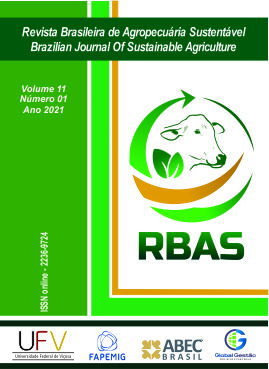EFEITO DE USOS E MANEJOS AGRÍCOLAS DO SOLO NO SEMIÁRIDO PIAUIENSE NA MACROFAUNA E CARBONO ORGÂNICO DO SOLO
DOI:
https://doi.org/10.21206/rbas.v11i1.12324Palavras-chave:
Agricultura familiar. Caatinga. Indicadores biológicos. Qualidade do Solo.Resumo
Atualmente a produção e comercialização de alimentos de caráter familiar tem afetado a qualidade do solo. No semiárido nordestino, esse tipo de exploração agrícola tem sido ainda mais intenso. Nesse contexto é de fundamental importância conhecer o impacto desses tipos de usos e manejos na qualidade do solo. O objetivo do trabalho foi avaliar o efeito dos diferentes usos e manejos agrícolas sobre a macrofauna e carbono orgânico do solo, na região semiárida do Piauí. As áreas estudadas foram: área sob vegetação nativa preservada; área sob cultivo de milho; área sob cultivo de capim mombaça e área sob cultivo de mandioca. Foram amostradas macrofauna epígea e edáfica. Para isso foram instaladas armadilhas do tipo PROVID e retirados monólitos de solo nas camadas nas camadas de 0,00-0,10 e 0,10-0,20 m. Além disso, foram coletas amostras de solo nas camadas de 0,00-0,05 e 0,05-0,10 m para avaliação do teor de carbono orgânico do solo. Os grupos Hymenoptera e Coleoptera ocorrem com maior frequência nas áreas cultivadas com capim mombaça, milho e mandioca, assim como na vegetação nativa preservada. A vegetação nativa preservada possui maiores valores de abundância, riqueza, diversidade e equitabilidade. A área cultivada com capim mombaça possui sistema de uso solo semelhante à vegetação nativa preservada. As áreas com cultivo de milho e mandioca diminuem a Abundância, Riqueza e os índices de diversidade e equidade da fauna, assim como os teores de carbono orgânico do solo. A Abundância, Riqueza, Índice de Shannon, Aranaea, Blattodea, Coleoptera, Diplopoda, Diptera, Himenoptera, Isoptera e Pseudoescorpionida, para a macrofauna epígea, a Abundância, Riqueza, Araneae, Hymenoptera, Blattodea, para a macrofauna edáfica e o COS são sensíveis ao manejo do solo utilizado.
Downloads
Downloads
Publicado
Como Citar
Edição
Seção
Licença
Copyright (c) 2021 Revista Brasileira de Agropecuária Sustentável

Este trabalho está licenciado sob uma licença Creative Commons Attribution-NonCommercial-NoDerivatives 4.0 International License.
1. Proposta de Política para Periódicos de Acesso Livre
Autores que publicam nesta revista concordam com os seguintes termos:
Autores mantém os direitos autorais e concedem à revista o direito de primeira publicação, com o trabalho simultaneamente licenciado sob a Licença Creative Commons Attribution que permite o compartilhamento do trabalho com reconhecimento da autoria e publicação inicial nesta revista.











